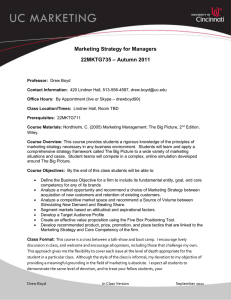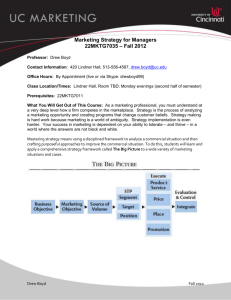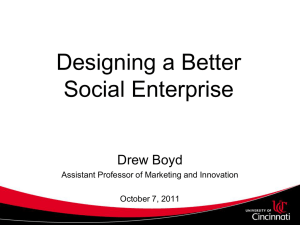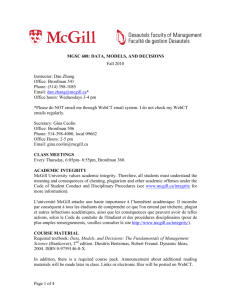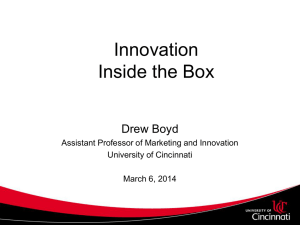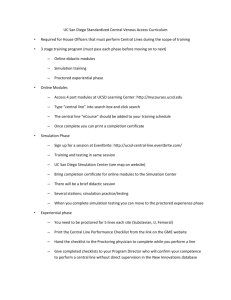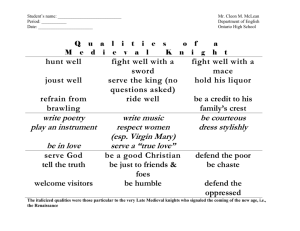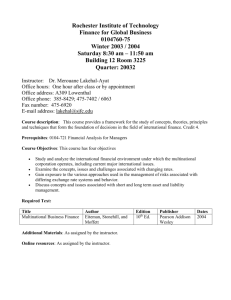22MKTG7035 – Fall 2012 - University of Cincinnati
advertisement
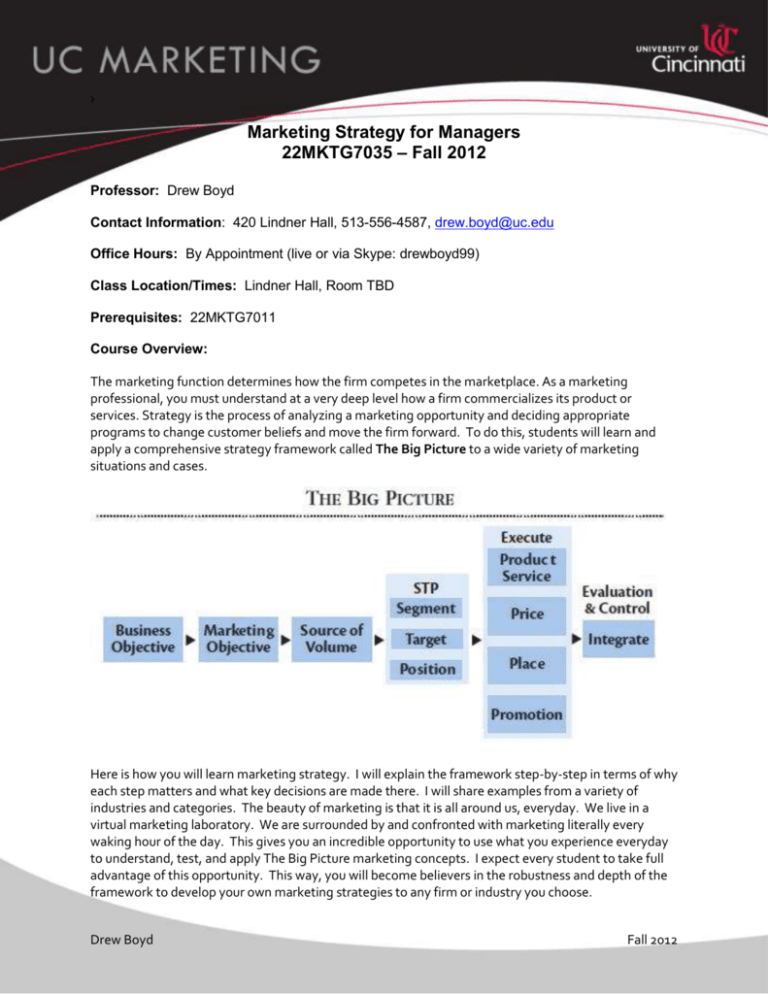
› Marketing Strategy for Managers 22MKTG7035 – Fall 2012 Professor: Drew Boyd Contact Information: 420 Lindner Hall, 513-556-4587, drew.boyd@uc.edu Office Hours: By Appointment (live or via Skype: drewboyd99) Class Location/Times: Lindner Hall, Room TBD Prerequisites: 22MKTG7011 Course Overview: The marketing function determines how the firm competes in the marketplace. As a marketing professional, you must understand at a very deep level how a firm commercializes its product or services. Strategy is the process of analyzing a marketing opportunity and deciding appropriate programs to change customer beliefs and move the firm forward. To do this, students will learn and apply a comprehensive strategy framework called The Big Picture to a wide variety of marketing situations and cases. Here is how you will learn marketing strategy. I will explain the framework step-by-step in terms of why each step matters and what key decisions are made there. I will share examples from a variety of industries and categories. The beauty of marketing is that it is all around us, everyday. We live in a virtual marketing laboratory. We are surrounded by and confronted with marketing literally every waking hour of the day. This gives you an incredible opportunity to use what you experience everyday to understand, test, and apply The Big Picture marketing concepts. I expect every student to take full advantage of this opportunity. This way, you will become believers in the robustness and depth of the framework to develop your own marketing strategies to any firm or industry you choose. Drew Boyd Fall 2012 Beyond the real world, we will also use the world of simulation to hone your strategy skills. The Big Picture Simulation will challenge you to analyze new and unfamiliar categories and make prudent strategy choices. The simulation is a progressive learning experience. We will start off rather modestly, then gradually “build muscle” in your strategy-making and strategy-implementing skills. Be patient! This is a journey. You will find the simulation a difficult but useful experience. Always keep in mind that I am not interested in you becoming an expert in “winning” the simulation. Don’t approach it like a video game. Rather, absorb the lessons learned through trial and error. Failure is your best teacher here. Learn from these mistakes in a safe environment so you don’t make career-ending mistakes later. I expect you to take risk, fail, and learn. If you play it safe, try to “win,” and claim “victory,” I will have a surprise waiting for you. Tip: Don’t go there. By taking this course, you are benefiting from my 30 years of experience in large organizations. That is the “value-added” here. I hope to share my insights about what works and what doesn’t work in the realm of commercial strategy. Marketing is a world of ambiguity. Your success in marketing is dependent on your ability to tolerate – and thrive – in a world where the answers are not black and white. Mastering strategy means using a disciplined framework like The Big Picture to analyze a commercial situation and then crafting forceful approaches to improve the commercial situation. When facing ambiguity, your only hope is the structure provided by an integrated framework. Strategy making is hard work. Strategy implementation is even harder. You are going to learn the best approach available to do both successfully. Becoming a great marketing strategist will help you do very good things for your company and its customers. For those students pursuing a master of science in marketing degree, take note. You will use all the skills and concepts taught in this course in your MS Marketing Capstone project. If you work hard and apply yourself here, you will set yourself up for a great, career-building experience in the Capstone. It is up to you, not me. Indeed, I will judge your performance in this course, especially the final exam, in determining what client and project you are ready for in the Capstone Experience. Course Text: Nordhielm, C. (2005) Marketing Management: The Big Picture, 2nd Edition. Wiley. Dr. Christie Nordhielm at The University of Michigan authored your textbook. She is a colleague and friend of mine, but that is not why I selected her text. I selected it because her method, The Big Picture, is the most comprehensive and effective marketing framework that I am aware of. I installed this framework at various divisions of Johnson & Johnson, and I continue to work with world-class companies like GE on installing it there. You will not find a better marketing strategy framework than The Big Picture. If you do, please let me know. You will be assigned chapters (called ‘modules’) throughout the course. I recommend you read the assigned modules after (not before) you attend the class about a specific topic. My experience suggests students learn and retain more from reading a text about a topic after they have heard me lecture about. You should read the assigned text to pull out Christie’s insights that are different than mine. She and I see “eye-to-eye” on many points, but not all. Take advantage of her great mind by absorbing the ideas in her text. Compare her ideas to mine. (Then, develop your own!). Drew Boyd Fall 2012 Course Objectives: By the end of this class students will be able to: 1. Understand the tools, language, and components of The Big Picture and the linkages between strategy and execution. (TOOLS) 2. Use The Big Picture framework to analyze and explain the commercial agenda of any firm in any industry. (ANALYZE) 3. Apply The Big Picture framework and tools to a firm to develop recommended commercial strategy. (APPLY) 4. Make decisions on marketing expenditures that achieve the desired marketing goal. (DECIDE) 5. Develop and defend a clear point of view regarding the strategic direction of a firm. (DEFEND) Class Format: This course is a cross between a talk-show and boot camp. I encourage lively discussion in class, and welcome and encourage all opinions, including those that challenge my own. This approach gives me the flexibility to cover each issue at the level of depth appropriate for the student in a particular class. My devotion to my objective of providing a meaningful grounding in the field of marketing is absolute. I expect all students to demonstrate the same level of devotion, and to treat your fellow students, your professor, and the learning process with the utmost respect. On this foundation we can work together to create a unique, memorable and extremely valuable course experience. Performance Evaluation: Assessment Participation (10 points per class) Mid Term Exam Mini Case Simulation Final Exam Total Leaning Objective DEFEND ALL ANALYZE, DEFEND ANALZE, APPLY, DECIDE ALL Points 150 150 150 150 400 1000 1. Participation (15%): In this course we will rely heavily on the discussion of cases to motivate learning of key concepts. The quality of the class is therefore heavily dependent on the quality of the contributions of the individual students in the class. For this reason, class participation accounts for a significant portion of the final grade. In order to excel in this area you must: Attend class. Although we live in a technologically and spiritually advanced age, it is still not possible to participate in this class without being physically present. If you believe you will miss more than two classes, you are strongly encouraged not to take this course. Please note that attendance in the first class is mandatory, with no exceptions. Prepare for class. This entails reading and understanding the assigned materials, and having a well-developed opinion for case discussion. Assignments for each week are listed in the syllabus and are also available online. You are expected to check the Blackboard course page on a weekly basis for updates and additional materials. Drew Boyd Fall 2012 Express and defend your opinion succinctly. The class participation grade is not based on how much time you spend talking; it is based on the quality of your responses to my general and cold-call questions. Focus on getting a few important points across. Please, do not express an opinion without some supporting evidence. Respond constructively to the opinions of fellow class members: It is impossible to learn only by speaking. Listening to and understanding the positions of your peers is a crucial part of this course. I will also rely on you to police each other: if you hear a statement you believe is not supportable or clear, ask for support or clarification. The value of this course to you will depend mightily on your willingness to take responsibility for the quality of the classroom discussion. Class participation is evaluated according to the following guidelines: Outstanding: Contributions in class reflect exceptional preparation. Ideas offered are always substantive and provide one or more major insights as well as a fruitful direction for the class. Arguments are well-supported (with tangible evidence) and persuasively presented. If this person were not a member of the class, the quality of the discussions would be diminished significantly. (15 points) Good: Contributions in class reflect thorough preparation. Ideas are usually substantive, provide good insights, and sometimes a fruitful direction for the class. Arguments, when presented, are generally well-supported and are often persuasive. If this person were not a member of the class, the quality of the discussion would be diminished. (10 points) Adequate: Contributions in class reflect satisfactory preparation. Ideas offered are sometimes substantive, provide generally useful insights, and occasionally offer a new direction for the class discussion. Arguments are sometimes presented and are fairly well-supported and sometimes persuasive. If this person were not a member of the class, the quality of the discussions would be a little diminished. (5 points) Non-participant: This person contributes little to the class. If this person were not a member of the class, the quality of the discussions would not be significantly changed. (0 points) 2. Simulation (15%): Students will be formed into groups to compete in a realistic marketing simulation built around The Big Picture Framework. The simulation will help you develop the skills to ANALYZE a market opportunity and APPLY The Big Picture to generate spending options. From there, you must DECIDE which programs to invest in to implement your marketing strategy. The simulation is a “safe” environment that allows you to fail where the career consequences are nil so you avoid making these mistakes when the consequences are high. 3. Mini-case (written 10%, oral presentation 5%): In addition to your individual participation, your group will be asked to prepare and present one case analysis on an assigned date. This will be a brief (no more than 15 minutes) presentation of a case developed by your group and circulated prior to class (see Blackboard mini-case materials). These presentations are intended to bring current, personally interesting issues into the classroom. The groups will prepare a brief, two-to-three page summary of a case of their choosing for distribution to the class a few days before their presentation. All class members will then review the case in preparation for a discussion in the following class. Presenting groups are encouraged to meet with me well in advance of the case presentation for input on this Drew Boyd Fall 2012 presentation. Examples of past cases and presentations prepared by students are on Blackboard. 4. Exams (55%): The mid-term exam will be a case study involving the simulation. It will test your understanding of the tools covered to date and your ability to apply them to the assigned case. The final exam will be a take-home exam, distributed on Wednesday, Week 10, and due back no later than Friday, week 15 (Exam Week) at 11:59pm. The exam will be a written case and simulation. You will be expected to analyze this case using the Big Picture Framework and submit a brief write-up of your analysis and recommendations. This analysis will be similar to the in-class work we do on the mini-cases and simulation. Complete instructions for the final exam will be distributed and covered during the last week of class. Grading Scale: A 94-100% A- 90-93% B+ 87-89% B 84-86% B- 80-83% C+ 77-79% C 74-76% C- 70-73% Schedule: Fall 2012 Date Session 1 August 27 Session 2 September 10 Session 3 September 17 Session 4 September 24 Session 5 October 1 Session 6 October 8 Learning Objective TOOLS Topic Business Objective Reading and Assignment Modules 1-2 TOOLS Marketing Objective Modules 3 TOOLS Source of Volume Module 4 ANALYZE APPLY DECIDE TOOLS Simulation Zima Case Segmentation Modules 5 TOOLS Targeting Module 6 Drew Boyd Fall 2012 Session 7 October 15 Session 8 October 22 Session 9 October 29 Session 10 November 5 Session 11 November 12 Session 12 November 19 Session 13 November 26 Session 14 December 3 Final Exam Week TOOLS Positioning Modules 7 TOOLS ANALYZE APPLY DECIDE DEFEND TOOLS ANALZE APPLY DEFEND TOOLS ANALZE APPLY DEFEND TOOLS ANALZE APPLY DEFEND TOOLS ANALZE APPLY DEFEND TOOLS ANALZE APPLY DEFEND TOOLS ANALZE APPLY DEFEND TOOLS ANALZE APPLY DECIDE DEFEND Mid Term Product Module 8-9 Mini-case 1 Mini-case 2 Promotion & Communications Module 10 Mini-case 3 Mini-case 4 Pricing Module 11 Mini-case 5 Mini-case 6 Place (Channel) Module 12 Mini-case 7 Mini-case 8 Integrate: Marketing Research Module 13 Team Presentations Prepare WOW team Presentations Final Exam Turn in exam not later than midnight December 15 Policies: Attendance, Participation, Technology, Evaluation Attendance/Participation: This is an experiential course, so attendance and participation is critical to learning. Students are expected to arrive to class on time as tardiness is disruptive and distracting for other students and the faculty supervisor. Attendance will be taken at each class – students will not receive credit for attending if they are more than 10 minutes late. There will be no discussion regarding this point. Only under extreme or dire emergency or in the case of a religious holiday is a student excused from class. Drew Boyd Fall 2012 Technology: Students will not receive credit if they are in class but engaged on their laptops, pdas, and/or cell phones. Cell phones must be in the off position during class. Students are expected to check Blackboard on a regular basis (at least every 48 hours). The faculty supervisor may send several emails each week during the course, some of which will require a reply from students. Students are expected to respond to the faculty supervisor’s email messages within 24 hours. Unless students have been notified in advance that there will be a delay, the faculty supervisor will respond to student voice mail and email message also within 24 hours. Students will receive the faculty supervisor’s mobile and home phone numbers at the first class session. Academic Integrity Policy: The University of Cincinnati Rules, including the Student Code of Conduct, and other documented policies of the department, college, and university related to academic integrity will be enforced. Any violation of the regulations, including acts of plagiarism or cheating, will be dealt with on an individual basis according to the severity of the misconduct. Plagiarism is the attempt to pass off another writer’s ideas or words as one’s own – this includes “lifting text” from a website. Submitting work not written by oneself or supplying work to another person for that purpose will result in receiving an F for the course. Please note that the UC Student Code of Conduct is printed on the UC web page at www.uc.edu/ucinfo/conduct.html. Special Needs Policy: If students have any special needs related to participating in this course, including identified visual impairment, hearing impairment, physical impairment, communication disorder, and/or specific learning disability that may influence performance in this course, the student should meet with the Faculty Supervisor to arrange for reasonable provisions to ensure an equitable opportunity to meet all the requirements of this course. Drew Boyd Fall 2012
